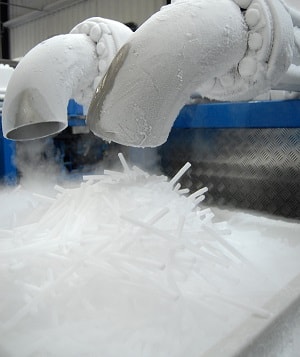Dry ice preparation
LCO2 tank:
Horizontal or vertical storage tank (30-60 tons) installed near the production site, but outside of the production area
Insulation lines, LCO2 filter and pressure regulators:
A copper line type "K", rated at 600 psi (40 bar) and wrapped in 2” to 4” insulation connects the storage tank to the production unit
Pouring:
The LCO2 is poured into chambers inside the production machines. Pressure is generated and LCO2 increases volume. About 2.3 to 2.5 pounds of liquid CO2 are used to produce 1 lb of dry ice
Production unit (pellets,press, reformer):
Then the CO2 snow is compressed, extruded or reconstructed in a specific shape (shavings, crumbs, pellet, plate or block) according to the needs of the end user
Abduction / recovery of gaseous CO2:
The escaped CO2 gas can either evaporate outdoors or be retrieved, compressed and liquefied again to LCO2

Dry ice manipulation
• Dry ice is too cold so avoid touching it with bare hands (may cause slight frostbite)
• Wear gloves or use a towel when handling dry ice to minimize skin exposure
• In Ho.Re.Ca companies it is suggested to handle dry ice with bartending scoop (scoop) or forceps
Storing dry ice
• Store dry ice in special insulated containers that we provide, to minimize sublimation.
• Do not store in spaces without ventilation. Dry ice sublimates into large amounts of CO2 gas, which displaces oxygen and increases the risk of suffocation.
• Do not store dry ice in airtight container(s). The container can explode due to sublimation and the spread of CO2
• Do not store in the freezer - the low dry ice temperature can deactivate the thermostat of the freezer
Ventilation
• Use dry ice in a well ventilated area to avoid the concentration of CO2 at high levels


